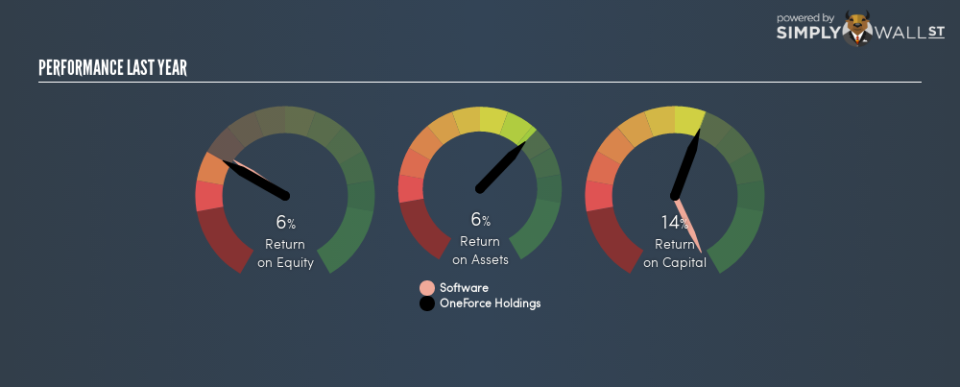Why We’re Not Impressed By OneForce Holdings Limited’s (HKG:1933) 14% ROCE

Today we’ll look at OneForce Holdings Limited (HKG:1933) and reflect on its potential as an investment. Specifically, we’ll consider its Return On Capital Employed (ROCE), since that will give us an insight into how efficiently the business can generate profits from the capital it requires.
First, we’ll go over how we calculate ROCE. Second, we’ll look at its ROCE compared to similar companies. Last but not least, we’ll look at what impact its current liabilities have on its ROCE.
What is Return On Capital Employed (ROCE)?
ROCE measures the ‘return’ (pre-tax profit) a company generates from capital employed in its business. All else being equal, a better business will have a higher ROCE. Ultimately, it is a useful but imperfect metric. Renowned investment researcher Michael Mauboussin has suggested that a high ROCE can indicate that ‘one dollar invested in the company generates value of more than one dollar’.
So, How Do We Calculate ROCE?
Analysts use this formula to calculate return on capital employed:
Return on Capital Employed = Earnings Before Interest and Tax (EBIT) ÷ (Total Assets – Current Liabilities)
Or for OneForce Holdings:
0.14 = CN¥32m ÷ (CN¥205m – CN¥17m) (Based on the trailing twelve months to September 2018.)
So, OneForce Holdings has an ROCE of 14%.
View our latest analysis for OneForce Holdings
Want to help shape the future of investing tools and platforms? Take the survey and be part of one of the most advanced studies of stock market investors to date.
Does OneForce Holdings Have A Good ROCE?
ROCE is commonly used for comparing the performance of similar businesses. OneForce Holdings’s ROCE appears to be substantially greater than the 2.9% average in the Software industry. We consider this a positive sign, because it suggests it uses capital more efficiently than similar companies. Separate from OneForce Holdings’s performance relative to its industry, its ROCE in absolute terms looks satisfactory, and it may be worth researching in more depth.
OneForce Holdings’s current ROCE of 14% is lower than 3 years ago, when the company reported a 35% ROCE. So investors might consider if it has had issues recently.
It is important to remember that ROCE shows past performance, and is not necessarily predictive. ROCE can be deceptive for cyclical businesses, as returns can look incredible in boom times, and terribly low in downturns. ROCE is only a point-in-time measure. How cyclical is OneForce Holdings? You can see for yourself by looking at this free graph of past earnings, revenue and cash flow.
How OneForce Holdings’s Current Liabilities Impact Its ROCE
Current liabilities are short term bills and invoices that need to be paid in 12 months or less. Due to the way ROCE is calculated, a high level of current liabilities makes a company look as though it has less capital employed, and thus can (sometimes unfairly) boost the ROCE. To check the impact of this, we calculate if a company has high current liabilities relative to its total assets.
OneForce Holdings has total assets of CN¥205m and current liabilities of CN¥17m. Therefore its current liabilities are equivalent to approximately 8.1% of its total assets. With low current liabilities, OneForce Holdings’s decent ROCE looks that much more respectable.
The Bottom Line On OneForce Holdings’s ROCE
If OneForce Holdings can continue reinvesting in its business, it could be an attractive prospect. Of course, you might find a fantastic investment by looking at a few good candidates. So take a peek at this free list of companies with modest (or no) debt, trading on a P/E below 20.
If you are like me, then you will not want to miss this free list of growing companies that insiders are buying.
To help readers see past the short term volatility of the financial market, we aim to bring you a long-term focused research analysis purely driven by fundamental data. Note that our analysis does not factor in the latest price-sensitive company announcements.
The author is an independent contributor and at the time of publication had no position in the stocks mentioned. For errors that warrant correction please contact the editor at editorial-team@simplywallst.com.


